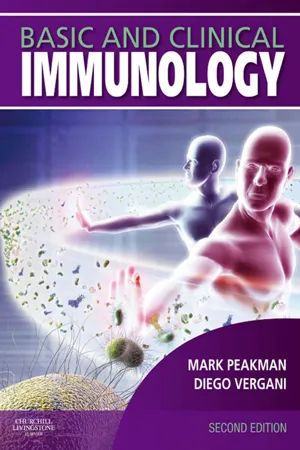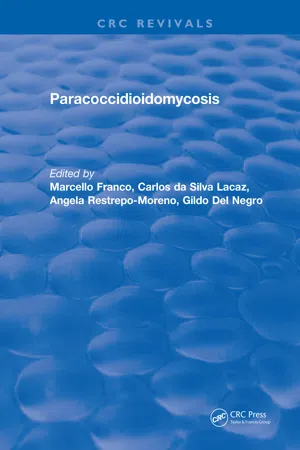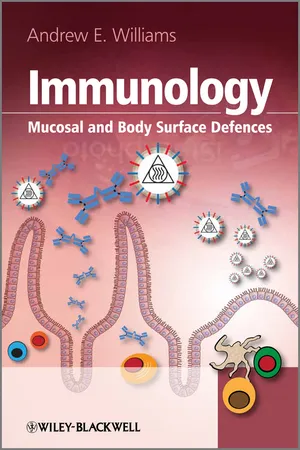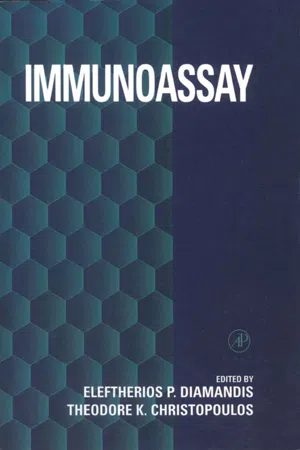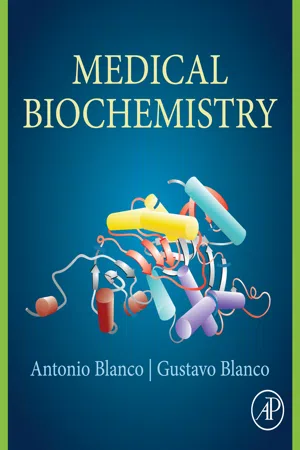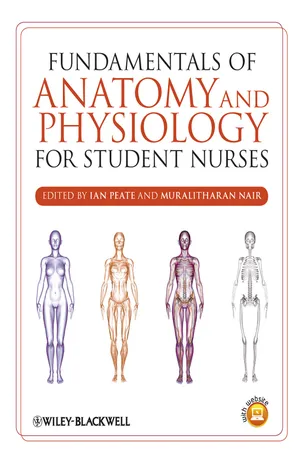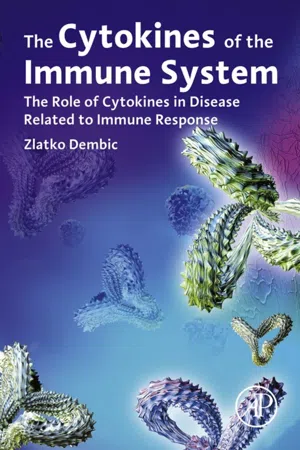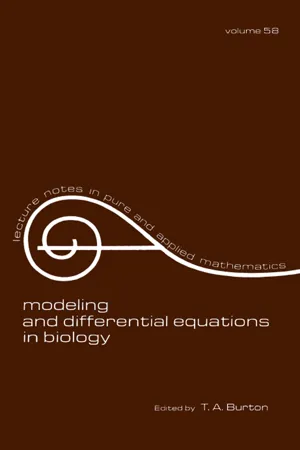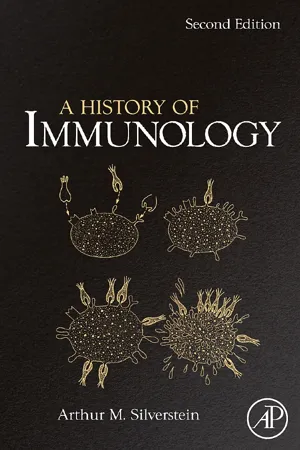Biological Sciences
Humoral Immunity
Humoral immunity is a component of the immune system that involves the production of antibodies by B cells. These antibodies circulate in the blood and lymph, targeting pathogens such as bacteria and viruses. Humoral immunity plays a crucial role in defending the body against infections and is particularly effective against extracellular pathogens.
Written by Perlego with AI-assistance
12 Key excerpts on "Humoral Immunity"
- eBook - ePub
Basic and Clinical Immunology
Basic and Clinical Immunology E-Book
- Mark Peakman, Diego Vergani(Authors)
- 2009(Publication Date)
- Churchill Livingstone(Publisher)
2 Innate immunity I: physical and humoral protection- Freedom from the burden of disease 11
- Types of immunity 11
- Complement 13
- Complement proteins 14
- Complement activation 14
- Complement pathways 15
- The classical pathway 15
- The mannan-binding lectin pathway 16
- The alternative pathway 16
- The membrane attack pathway 17
- Complement control mechanisms 18
- Complement receptors 19
- Biological activities generated by complement activation 20
- Opsonisation 20
- Cell recruitment and activation 20
- Cell lysis 20
- Removal of immune complexes 20
- Other factors in Humoral Immunity 22
Freedom from the burden of disease
The Latin immunis , meaning free from burden , has provided the English term immunity; it is often used in non-scientific contexts such as diplomatic immunity, crown immunity and so on. In biology, the burden is disease — caused by a variety of viruses, fungi, bacteria, protozoa, worms and toxins — and the physiological role of the immune system is to keep it at bay.A broad definition of the immune system would be that it evolved to be able to identify self , and thus recognise non-self . The ability to make such a distinction is relatively primordial: sea anemones also have the capacity to recognise and react to non-self. The immune system in humans is often challenged by non-self, including pathogens such as those described above as well as organs transplanted from un-related donors. Protection from these is afforded by a variety of cognitive and destructive processes, the understanding of which forms the basis of immunology.Immunity from infection is the result of a complex process, as we shall see, but there are some general principles about immunity that we can deduce from our own everyday experience. For example, some features of protection from infection are obvious: if you have an open wound or burn, it is important to maintain cleanliness and protect the exposed tissues from becoming infected. Thus, loss of physical bar-riers lowers immunity. We also know that some infections can arise at any age and be dealt with by the immune system without necessarily needing antibiotics. On the other hand, we consider the newborn to be at greater overall risk of infection: they have less immunity. Other well-recognised truths relate to the infections of childhood. If you have chicken pox as a child, you are extremely unlikely to suffer the same illness again. However, having had chicken pox would not stop a child catching measles. We can conclude that we are born with some immunity and that the rest may be acquired during life; immune responses can be highly specific for a microbe: they may be learned and retained in an ‘immunological memory’. - eBook - ePub
- M. Franco M.D.(Author)
- 2018(Publication Date)
- CRC Press(Publisher)
Chapter 12Humoral Immunity
Zoilo P. Camargo and E. Cano R. Luz Table of Contents- I. Introduction
- II. Activation of B cells
- A. B-Cell Response to Different Types of Antigen
- B. Polyclonal B-Cell Activation
- 1. Ig Secreting Cells (IgSC)
- 2. Hypergammaglobulinemia
- 3. Circulating Immune Complexes (CIC)
- III. Antibody Response
- A. Subclasses of Antibodies
- B. Lymphokine Control
- IV. Complement System
- A. Inflammatory Response Mediated by Complement
- V. Other Humoral Factors
- A. Iron-Binding Compounds
- B. Mammalian Steroid Hormones
- VI. Conclusions
- References
I Introduction
Immunity to infection involves a constant struggle between host defenses and the microorganisms. In paracoccidioidomycosis, like in other systemic mycoses, the course and outcome of the infection are determinated mainly by the interactions between the fungus — Paracoccidioides brasiliensis — and various host defense mechanisms.In the normal host, these host-parasite interactions can trigger specific as well as nonspecific immune responses. The immune response results from the proliferation and differentiation of individual clones of lymphocytes processes which are precisely regulated. The main function of B lymphocytes is to produce immunoglobulins (Ig). These proteins play a crucial role in defense against a variety of infectious microorganisms; they are present in high concentrations in body fluids and in stable form. These properties led to their relative ease of detection and quantitation, providing major criteria for the presence and activity of the disease (serodiagnosis), and for monitoring both evolution of the disease and response to treatment. - eBook - ePub
- Abul K. Abbas, Andrew H. Lichtman, Shiv Pillai(Authors)
- 2023(Publication Date)
- Elsevier(Publisher)
Humoral Immune Responses Activation of B Lymphocytes and Production of Antibodies- Phases and Types of Humoral Immune Responses
-
Stimulation of B Lymphocytes by Antigen
- Antigen-Induced Signaling in B Cells
- Role of Innate Immune Signals in B Cell Activation
- Functional Consequences of B Cell Activation by Antigen
-
Functions of Helper T Lymphocytes in Humoral Immune Responses
- Activation and Migration of Helper T Cells and B Cells
- Presentation of Antigens by B Lymphocytes to Helper T Cells
-
Mechanisms of Helper T Cell–Mediated Activation of B Lymphocytes
- Extrafollicular and Germinal Center Reactions
- Heavy-Chain Class (Isotype) Switching
- Affinity Maturation
- Generation of Plasma Cells and Memory B Cells
- Antibody Responses to T-Independent Antigens
-
Regulation of Humoral Immune Responses
- Antibody Feedback
- B Cell Signal Attenuation by Other Inhibitory Receptors
- Summary
Humoral Immunity is mediated by antibodies and is the arm of the adaptive immune response that functions to neutralize and eliminate extracellular microbes and microbial toxins. It is the principal type of immune response against extracellular microbial protein antigens, as well as against nonprotein antigens, such as microbial capsular polysaccharides and lipids that cannot be recognized by most types of T cells. Antibodies are produced by B lymphocytes and their progeny. Naive B lymphocytes recognize antigens but do not secrete antibodies, and antigen-induced activation of these cells stimulates their differentiation into antibody-secreting plasma cells and memory cells. - eBook - ePub
Immunology
Mucosal and Body Surface Defences
- Andrew E. Williams(Author)
- 2011(Publication Date)
- Wiley(Publisher)
Specialized lymphocytes, known as B cells, can also secrete numerous proteins called antibodies, which are found in bodily fluids such as the blood serum and lymphatics. The role of antibodies within the immune system is to recognize and bind to foreign proteins derived from microorganisms. Any protein that can be bound by an antibody is known as an antigen. The interaction between an antibody and an antigen is a key principle in immunology. The binding of an antibody to an antigen has several downstream consequences, including the neutralisation and clearance of the antigen, and the activation of the effector functions of numerous immune cells. Often the word antibody is interchanged with the word immunoglobulin, as these two terms describe the very same molecule. The functional consequences of antibody and antigen interactions will be discussed further in this chapter and in subsequent chapters. Immune responses generated as a result of antibody and antigen interactions are commonly referred to as antibody-mediated immunity, which can be considered to be part of the humoral immune response. Any immune component that affords protection and is not associated with the cellular fraction of body fluids is considered humoral.In addition to PRRs, released soluble mediators and antibody, the immune system utilizes a number of specialized cells that participate in cell-mediated immunity. The mechanisms of cell-mediated immunity are largely independent of antibody and other humoral factors (such as complement proteins). Cell-mediated immunity involves the activation of immune cells and the subsequent deployment of cellular effector functions. For example, macrophages and neutrophils participate in cell-mediated immunity by phagocytosing invading pathogens, or infected host cells, and releasing a cascade of antimicrobial products. Phagocytosis is an important process that engulfs foreign substances and microbes and clears them from the body. NK cells and T cells also participate in cell-mediated immunity by recognizing and lysing virally infected cells. This mechanism is known as cytotoxicity, which kills infected or abnormal cells. The cells that are involved in cell-mediated immunity also secrete a number of cytokines, which regulate any ongoing immune response. Historically, cell-mediated immunity has been separated from antibody-mediated immunity or Humoral Immunity, depending on whether immunological protection can be found in the cellular fraction or the cell free fraction of body fluids, respectively.Therefore, the key concepts in immunology can be summarized as components that activate immune cells and initiate immune responses, soluble mediators that signal to immune cells and regulate the immune response, components of antibody-mediated immunity (and also other humoral components), and constituents of cell-mediated immunity.1.4 Innate Versus Adaptive ImmunityComponents of the immune system can be conveniently grouped into either the innate immune system or the adaptive immune system (Table 1.1 ). The innate immune system encompasses all those aspects of non-cellular immunity, including epithelial barrier defence, antimicrobial peptide secretion, chemical barriers and the complement system. The innate immune system also involves aspects of cellular immunity associated with granulocytes (neutrophils, eosinophils, basophils and mast cells), monocytes, macrophages, DCs and NK cells. Cells of the innate immune response are rapidly initiated and are considered to be the first line of cellular defence against invading microorganisms (Figure 1.6 - eBook - ePub
- Eleftherios P. Diamandis, Theodore K. Christopoulos(Authors)
- 1996(Publication Date)
- Academic Press(Publisher)
2IMMUNE FUNCTION AND ANTIBODY STRUCTURE
CAROLYN S. FELDKAMP and JOHN L. CAREY, Henry Ford Hospital & Health Care Corporation, Detroit, Michigan1 Cellular and Molecular Basis of the Humoral Immune Response1.1 Antigen-Presenting Cells 1.2 T Cells 1.3 B Cell Stimulation and Immunoglobulin Production2 Antibody Structure2.1 Function and Structure 2.2 Basic Structure 2.3 Heavy Chains 2.4 Light Chains 2.5 Variable and Constant Regions 2.6 Three-Dimensional Structure 2.7 Fragments 2.8 Carbohydrates 2.9 Structural Features of the Immunoglobulin Classes3 Antigen Binding3.1 Antigen-Antibody Interaction 3.2 Antigen Binding Site 3.3 Hypervariable Regions 3.4 Idiotype 3.5 Antigen4 Antibody Structure and Immunologic Diversity4.1 Theories of Antibody Diversity 4.2 Light-Chain Gene 4.3 Heavy-Chain Gene 4.4 Isotype Switching5 Conclusion5.1 Relationship between Antibody Structure and in Vivo Function5.2 Relation of Antibody Structure to in Vitro ActionsReferences1. CELLULAR AND MOLECULAR BASIS OF THE HUMORAL IMMUNE RESPONSE
The primary role of the humoral immune system is the elimination of foreign biomolecules and organisms, along with effete self-proteins and cells. This is accomplished by the binding of allo- and autoantigens with immunoglobulin. Subsequent responses, including activation of the complement and/or cellular immune systems, eventually lead to the phagocytosis and destruction of the target cell, virus, or protein.To effectively accomplish this task, it is necessary that the immune system recognizes a very large range of non-self-antigens (foreign or alloantigens), usually at low concentrations. Failure to do so will result in immunodeficiency. Further, the immune system must manage to effectively respond to alloantigens without either overreactivity with self-antigens (loss of tolerance—autoimmune disease) or inappropriate response to immune stimulation (IgE production—allergy). Last, there must be an appropriate “damping” of a reaction when the desired effect (clearance) is accomplished. - eBook - ePub
- Antonio Blanco, Gustavo Blanco(Authors)
- 2017(Publication Date)
- Academic Press(Publisher)
Chapter 30Molecular Basis of Immunity
Abstract
The immune system is actively involved in the protection of the body against invading foreign agents. It consists of two different systems, innate and adaptive. The innate system is unspecific and it does not require prior exposure with the foreign agent to respond. Phagocytic cells with TLR (toll-like receptors ) recognize molecules in microorganisms and initiate an inflammatory process or promote the release of interferons. Adaptive system is specific and its response is enhanced by new encounters with the invading agent; it can develop memory against the aggressor. It is mediated by B and T lymphocytes , located in lymphoid organs and circulating blood. The B cells are involved in the production of immunoglobulins (Ig) or antibodies (Humoral Immunity ); the T lymphocytes are effectors of the cell-mediated immunity (cellular immunity ). Antigens (Ag) are agents (microorganisms, particles, cells, or molecules) that can trigger the immune response. Small portions of the antigen (antigenic determinants or epitopes ), recognized as foreign by the immune system, are responsible for the immune reaction. Humoral Immunity depends on the production of antibodies by B lymphocytes. Immunoglobulins are composed of a structural unit of four polypeptide chains linked together by disulfide bridges. Two are the heavy or H chains and the other two are the light or L chains . Variable segments of L and H form the complementarity determinant regions which recognize an epitope in the antigen. Five classes of Ig exist that differ in their heavy chain. IgG, IgA, IgM, IgD, and IgE contain γ, α, μ, δ, and ɛ chains, respectively. Light chains can be either of two types, κ or λ. IgG, IgD, and IgE are monomers, IgM are pentamers and IgA are dimers of the basic Ig structure. An individual is capable of synthesizing more than 107 Igs with different specificities. This heterogeneity in Ig synthesis is achieved through rearrangement of the genes encoding the variable portions of H and L chains. Monoclonal antibodies have identical antigen specificity and are synthesized by plasma cells derived from the same clone. The complement includes a series of plasma proteins that are involved in body defense, promoting the lysis or phagocytosis of foreign cells, bacteria, and viruses. The complement proteins circulate as zymogens, which are activated by a sequential cascade of reactions. Two pathways for complement activation are known. The classical pathway is activated by antigen–antibody complexes. The alternative pathway is activated by macromolecules on the surface of microorganisms. Cellular immunity is carried out by effector T cells , of which there are several types: helper (TH ), killer (TK ), and suppressor (TS ) cells. T-cell receptors recognize the Ag only if it is bound to the major histocompatibility complex (MHC or HLA in humans) on the surface of accessory cells. T cells recognize foreign MHC proteins in organ grafts and are responsible for transplant rejection. After T cell recognition, the cells carrying the foreign MHC proteins are eliminated. Cytokines are proteins secreted by cells of the immune system with paracrine or autocrine action. Their general role is to regulate the immune response and to promote inflammation. Interferons - Ian Peate, Muralitharan Nair(Authors)
- 2011(Publication Date)
- Wiley-Blackwell(Publisher)
The body is constantly under attack from organisms out to destroy it. This may sound dramatic, but it is true. Infectious micro-organisms, toxins and pollutants are some of the harmful substances from which it has to defend itself. Fortunately, the body has evolved and developed many defences to repel and destroy these harmful substances.Immunology – the study of the immune system – is a relatively new branch of bioscience and medicine. Although some of the mechanisms and components of immunity, such as antibodies and blood cells, have been known for some time, it is only recently that so much research has been undertaken into the immune system.Without a doubt, the onset of HIV and AIDS in the 1980s was the trigger for much of this research, and it is now accepted that the immune system is a complicated and wonderful system which underpins so much of the understanding of disease and disease process, and not only those diseases caused by infectious micro-organisms.This chapter will show what the body’s acquired and innate immune defences consist of and how they work together to give the body a good chance of surviving the continuous and continuing assaults by micro-organisms, toxins and other pollutants, to which it is subjected.Blood cell developmentAll our blood cells are descended from a particular type of cell known as the multipotent stem cell. This multipotent stem cell- eBook - ePub
The Cytokines of the Immune System
The Role of Cytokines in Disease Related to Immune Response
- Zlatko Dembic(Author)
- 2015(Publication Date)
- Academic Press(Publisher)
Its mechanisms are partially known, however, the explanations seem still complicated. In recent years, with novel theories about the function of the immune system, explanations became somewhat simplified, and the need for an adjuvant received a significant place in them (see Theories about the function of the immune system, Chapter 9). A more detailed description of the immune response and the role of its cytokines can be found in the following section: Cellular adaptive (specific) immune system, p. 42. Humoral Innate (Nonspecific) Immunity Innate immunity of the humoral type involves soluble factors outside and inside the body. The Factors Secreted in Mucosal Surface Those that are outside (and secreted in the oral mucosa by salivary glands) consist of enzymes, proteases, and factors that are combating intruding microorganisms, aiming to prevent their entry into the organism. These include (in mucosal surfaces of the oral cavity) lysozyme, LPO-SCN, various mucins, histatins, human beta-defensin (HBD) (β-defensins), lactoferrin, and cystatins. Together with humoral adaptive factors (soluble immunoglobulin type A—sIgA, and soluble immunoglobulin type M—sIgM) they are the first barrier that basically excludes most of the microbes and parasites, which might try to penetrate the oral cavity mucosa. Those microbes that are eaten are confronted by the next set of defensive factors, which are not strictly considered innate immunity, but definitely contribute to the elimination of potential pathogens. Namely, the set comprises the stomach acid and digestive enzymes of the gastrointestinal tract. If the microbes penetrate the organism through epithelial barriers they face humoral and cellular immune system - eBook - ePub
- T. A. Burton(Author)
- 2017(Publication Date)
- Routledge(Publisher)
MATHEMATICAL MODELS OF HUMORAL IMMUNE RESPONSE Stephen J. Merrill Department of Mathematics and StatisticsMarquette UniversityMilwaukee, Wisconsin INTRODUCTIONThis is a survey of several mathematical models of the humoral immune response. They are predominantly models of the population levels and interaction of various cell types involved in the response as well as the associated production of antibody and the removal of antigen from the system.Each model is discussed separately and the notation is as it appears in the original papers. Some simplifications in the models have been made to make comparison with the others easier. These are generally noted in the discussion.The models here all involve differential equations. The mathematical analysis of the systems as it has been developed is given in capsulary form, both to indicate the methods and maybe suggest extensions to these results.OUTLINE OF THE IMMUNE RESPONSEThe immune system is a set of organs, cells, and proteins which responds to the presence of a foreign substance in the body. The response is twofold: (1) the humoral response and (2) the cell-mediated response. The humoral response results in the production of a heterogeneous collection of proteins called antibodies which are specifically aimed at a molecular pattern or antigenic determinant on the surface of the foreign substance called an antigen. These antibodies react and bind with the antigen forming antigen-antibody complexes which hasten the destruction and removal of the antigen from the body. The cell-mediated response involves a large number of different phenomena which result in destruction of the antigen without presence of antibody. This response is especially important in the response against fungi, certain viruses, and protozoa.Both responses have small lymphocytes as important participants. These come in two types: (1) the B-cell which will evolve into antibody-producing cells, and (2) the T-cell - eBook - ePub
- Arthur M. Silverstein(Author)
- 2009(Publication Date)
- Academic Press(Publisher)
Chapter 2. Cellular vs Humoral Immunity....one of Metchnikoff's most suggestive biological romances...George Bernard Shaw, The Doctor's DilemmaIn a major address to the congress of the British Medical Association in 1896, Lord Lister suggested that if ever there had been a romantic chapter in the history of pathology, it was certainly that concerned with theories of immunity. Lister's reference was to two epic but interrelated battles that had occupied pathologists, bacteriologists, and immunologists over the course of several decades – battles which saw opposing schools engage in passionate debate and a degree of vilification almost unknown in present-day science. When Lister spoke in 1896, the first of these great disputes was nearing its resolution. This involved the question of the basic nature of the inflammatory reaction – whether inflammation is an abnormal response harmful to the host, or a normal and beneficial component of its defensive armamentarium. However, the second of these battles had not yet been resolved, and was still being fought in every journal and at every congress relating to the subject. Its focus was on the question of whether innate and acquired immunity to infection could be best explained by cellular or by humoral mechanisms. In that exciting decade when remarkable discoveries crowded close on one another's heels, when new mechanisms, new organisms, new diseases appeared with almost every issue of the journals, the protagonists from one or the other camp grasped each new item eagerly to bolster their own theory, or to cast doubt upon that of the opposition.The lines that divided the two camps were fairly sharply drawn. Conceptually, the cellularists argued that the chief defense of the body against infection resided in the phagocytic and digestive powers of the macrophage and the microphage (the polymorphonuclear leukocyte), while the humoralists claimed that only the soluble substances of the blood and other body fluids could immobilize and destroy invading pathogens. Geographically, the cellularists were predominantly French and rallied round Elie Metchnikoff at the Pasteur Institute in Paris, while the humoralists were predominantly German and followed the leadership of Robert Koch and his disciples at Koch's Institute in Berlin. - eBook - ePub
- Anna Dee Fails, Christianne Magee(Authors)
- 2018(Publication Date)
- Wiley-Blackwell(Publisher)
Chapter 16 Body Defenses and the Immune System- Nonspecific Defenses
- Specific Immune Response
- B Lymphocytes
- Immunoglobulins
- T Cells and Cell‐Mediated Immunity
- Lymphocyte Origin, Development, and Residence
- Active and Passive Immunities
- Immunological Surveillance
- Lymphatic System
- Lymphatic Vessels
- Lymph Nodes
- Spleen
- Thymus
- Tonsils
Learning Objectives
- Define and be able to explain the significance of the bold italic terms in this chapter.
- Define the concept of immunity and generalize the mechanisms by which an animal can mount nonspecific versus specific defenses to foreign substances.
- Compare and contrast the location and function of each of the different immunoglobulins.
- Compare and contrast the location and function of each of the major structures of the lymphatic system.
- Illustrate the differentiation of lymphoid stem cells in the three general classes of lymphocytes. Be sure to include how this maturation process also dictates function in the mature cell.
- What is lymph and why does it need to be filtered?
- What is the direction of flow within the lymphatic vessels and how does it contribute to immunologic surveillance? For example, an infection in the distal hindlimb versus distal forelimb – which would result in an enlarged popliteal lymph node?
Body defense is protection against injury; immunity is protection against foreign microorganisms or the harmful effect of antigenic substances (antigens). Antigens are molecules that can stimulate an immune response directed at that specific molecule, and in most cases antigens are either components of foreign cells or secretions by microorganisms. While the ability to mount immune responses is part of the body’s defenses, it is not the only means by which the body is defended. A number of nonspecific defenses - eBook - ePub
Exploring Immunology
Concepts and Evidence
- Gordon MacPherson, Jon Austyn(Authors)
- 2013(Publication Date)
- Wiley-Blackwell(Publisher)
6 Antibody-Mediated Immunity6.1 Introduction
B lymphocytes play a crucial part in adaptive immunity. They give rise to plasma cells that secrete antibodies, as well as memory B cells. These are crucial for immediate and long-term defence against many infectious agents. B cells appear to have co-evolved with T cells. Antibodies are structurally very similar to T cell receptors (TCRs) and the processes that generate the enormous diversity of antibody specificities in B cells are very similar to those that occur in T cells. We do not fully understand how two different types of lymphocyte appeared in evolution, but it is clear that B and T cells do recognize antigens in very different ways. This evolution may have been facilitated by two entire genome replications that occurred before and during the Cambrian explosion some half a billion years ago. The duplicated sets of chromosomes now enabled a group of genes on one chromosome to diversify from their original forms and to assume new functions. This may have allowed the generation of closely related but different types of antigen receptor during evolution of the two main types of lymphocyte.In this chapter we discuss the functions of different types of antibodies in host defence, and describe how B cells can make different types of response against infectious agents. We start by noting that there are different types of response against B cells that can develop into plasma cells that make different types of antibodies, sometimes against different classes of molecular structures (Section 6.1). We then explain how it is possible for antibodies to recognize so many different kinds of molecule, before considering the different types of antibody, where they are commonly found and how they help in host defence against infection (Section 6.2). We then describe how different types of B cell can recognize different types of infectious agents and produce antibodies against them in different ways – and how in many cases they need to collaborate with T cells in order to synthesize the most appropriate type of antibody. We describe the anatomy and physiology of B cell activation and antibody synthesis (Section 6.3), and show how long-term resistance to infection can occur through antibodies (Section 6.4). We explain how and where different types of B cell develop and why it is that antibodies do not normally recognize components of the host itself, a part of immunological tolerance (Section 6.5). Finally, we outline how antibodies can be produced and used as tools for the treatment of diseases (Section 6.6)
Index pages curate the most relevant extracts from our library of academic textbooks. They’ve been created using an in-house natural language model (NLM), each adding context and meaning to key research topics.
Explore more topic indexes
Explore more topic indexes
1 of 6
Explore more topic indexes
1 of 4
